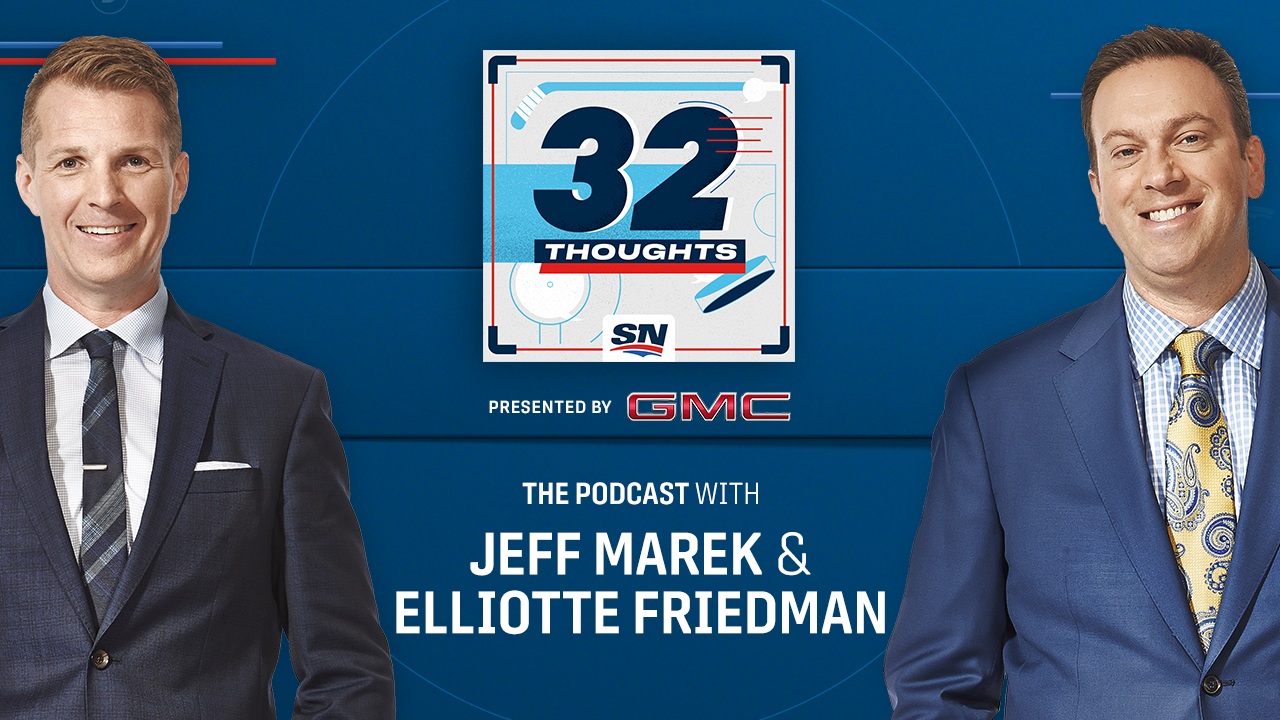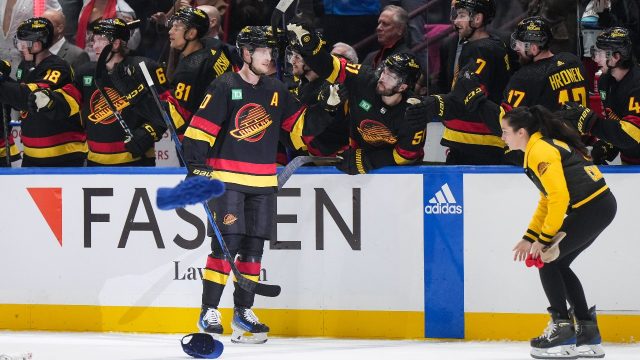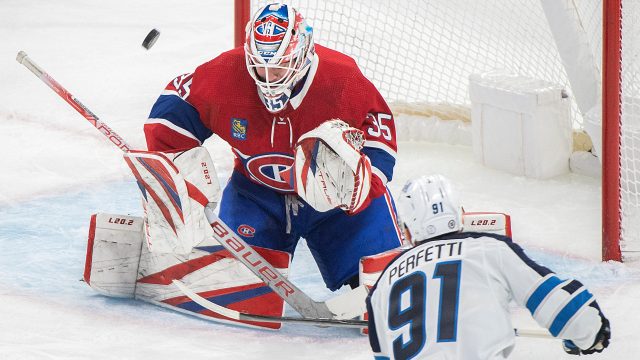MONTREAL— A ton of great questions came for this week’s mailbag, so let’s unpack it — starting with three on the same theme that I’m grouping together for a big-picture response.
I have a particular belief about this Canadiens rebuild and, judging by these three questions, it appears I’m not the only one.
It seems the people who asked them can see the team is steadily progressing, the culture is growing strong, most of the individuals are taking steps in their development — some of them, like Kaiden Guhle, leaps — and they have to feel the Canadiens recognize all that, too. It wouldn’t be unreasonable for these fans to expect, based on those results, that management do whatever it can to accelerate things further. And it seems clear they believe, like I do, that the top accelerant to the rebuild would be the acquisition of a winger who can play alongside Nick Suzuki or Kirby Dach and score at nearly the same rate as Cole Caufield is capable of.
I’ve been saying for a while now — on Sportsnet radio, and on the podcasts I contribute to — that this whole thing turns as soon as the Canadiens acquire that exact kind of player. They’ll need more help in the scoring department, but this one would be the lighter fluid this fire needs.
What I’m not sure of, though, is whether or not signing this type of player will be the way to go about it. Especially considering the assets the Canadiens have already accumulated — and the ones they’re likely to scoop up between now and the 2024 trade deadline.
If the Canadiens want to pick up a great player next summer, they have 29 picks spread over the next three drafts — 17 of them in the top-four rounds — to dangle. They have one of the deepest prospect pools in the NHL to deal from and they have an abundance of left-shot defencemen from the top of their NHL depth chart all the way down to the junior/college ranks who could prove very appealing to other teams. And think about what else gets added to the cupboard if they deal Sean Monahan, Tanner Pearson and David Savard for futures before March 8.
Hey, nothing prevents the Canadiens from wading into free agency next summer with an open pocketbook while also considering moving appreciating assets for established players on the trade market. And I’m not necessarily of the opinion that one route is better — or less risky — than the other.
But I do believe that timing is a big part of the equation when it comes to free agency, and that’s on top of the uncertainty of whether or not a player is willing to play in Montreal.
But let’s assume the two pending unrestricted free agents I was asked about are willing to do exactly that; the real question becomes does the timing really make sense for the Canadiens? Because both Nylander and Lindholm will be 28 and 30, respectively, by the beginning of next season, and they’ll be playing the first of what’s likely to be their three best years under whatever contract they sign.
If the Canadiens are going to pay top dollar for either of them — and make no mistake, it’s going to cost nothing less than that to sign Nylander, and Lindholm will be priced highly, too, based on his body of work — they have to not only believe they’re ready to start competing for playoffs in Year 1 but also believe they can win the Stanley Cup.
The Canadiens are almost in the same boat trying to trade for Hertl, who has a no-movement clause in his contract.
Assuming he’d waive it for Montreal, his cap hit ($8.137M) is indeed digestible.
But it’s not all that palatable knowing he’ll be 31 next November and he’s signed until the summer of 2030.
Again, you make this type of move when you’re closer to Cup contention, and not just when you think you should be making the playoffs, because the asset isn’t all that far off from declining.
Even if the Canadiens were to add any one of these three players, I don’t think they’d be quite that far along in their process in Year 1. The promising defence, which is at the foundation of their future contention, still needs another year of experience after this one, and that maturation is going to coincide with Cole Caufield, Nick Suzuki and Kirby Dach all entering their primes.
Knowing that, I can envision general manager Kent Hughes feeling more incentivized to dive into free agency come summer 2025 rather than doing anything more than dipping his toes in next July.
But man, he is going to have incredible opportunities in between to add the pieces through trade that accelerate this rebuild. And Hughes is going to have to do exactly that just to make room for players like Lane Hutson, David Reinbacher, Logan Mailloux, Owen Beck and Joshua Roy, amongst others who are on their way up.
He’ll have to save some money for Dach, Guhle, Justin Barron and Juraj Slafkovsky moving forward, but the cap should be exponentially increasing year over year — at least for the next few — and he’s going to be in prime position to do exactly what the Canadiens need him to do to improve them.
Elite talent up front will be a priority, so will goaltending, and it’s not going to be long before those boxes start getting checked.
At this point, it would be much more surprising if Hutson didn’t sign at the end of his college season than it would be if he did.
I don’t think the Canadiens are going to hesitate. His development has been astounding since he was taken 62nd overall in the 2022 draft and, judging by how his season is going at Boston University, returning for another one at that level would only stunt it.
How much more does Hutson really have to prove in the NCAA anyway? He came into Friday’s game having already recorded eight goals and 11 points in nine contests after scoring 15 goals and 48 points as a freshman last season, and he came out of it with an assist in a win over Maine. He’s appeared ready for pro hockey for some time already.
It doesn’t hurt Hutson to be in college, though, between now and when he signs with the Canadiens. The five-foot-10, 161-pounder has five days per week to train when he’s not playing games and continuing to bulk up will be the most important thing he does before making the transition to the NHL.
It’s coming soon. I don’t think there’s anything to worry about in this dossier.
Hey Andre, you hit me in the sweet spot. Love any question about music, and I do partake in the Phish.
Assuming most of my readers don’t, though, and therefore might not know what they’re missing,
I think a section of Character Zero could really work as a goal song for any team.
But I think this song, from 2:43 until 3:16 could really work for Canadiens fans, who already have an interactive one playing each time their time scores at the Bell Centre. I just find there’s a good repetitive refrain in Trey’s guitar solo that works perfectly, ending with the “I” chants, which serve as a good hook for the fans to sing along with.
As for your second question, which I’m sure is more appealing to the wider fanbase: I would put money on Roy playing at least one game with the Canadiens this season.
It wouldn’t surprise me at all if it was more than that.
In an ideal world, if not purely from an asset management perspective, the Canadiens would trade Jake Allen and keep Cayden Primeau.
Also, from an asset management perspective, they’d sign Samuel Montembeault before doing anything. Wouldn’t be a good move for them to trade a goaltender before securing the one most likely to be a viable future option for them.
Once that gets settled — and it seems it’s on its way to getting settled, barring some sort of catastrophic breakdown in talks Elliotte Friedman reported and Montembeault confirmed are picking up — it’s hard to predict how the Allen/Primeau stuff gets sorted.
Allen is 33, steady as can be, and any team scouting the Canadiens knows he’s been excellent so far, with his numbers only affected by one game against the Lightning when the team fell asleep in front of him and hung him out to dry. I don’t even think his $3.8-million cap hit through the end of next season would be an impediment to moving him.
But his seven-team no-trade clause could be, especially considering the team(s) most in need of a veteran goaltender of his ability.
Say it isn’t, though, it’s not a given that moving Allen makes the most sense. The return has to be reasonable, and the Canadiens need to believe Primeau wants to be in Montreal for the future and will be worth more to them than he would be on the market.
There are a couple of teams I know of that really believe in Primeau, and they’d jump at the opportunity to claim him if he were waived. That’s why he remains with the Canadiens for the time being.
But this three-goalie rotation isn’t likely to last the season, and it’s entirely likely it ends with Primeau or Allen changing teams.
Meanwhile, the Canadiens have handled it well, and so have the goaltenders. It’s not ideal for any of them, but they’re making the best of it and will have to continue to do so to maintain their value to the team and on the market.
OK, I get where this question is coming from. Caufield has one goal since being separated from Suzuki on Nov. 9 in Detroit, and that one goal came in overtime, when he was on the ice with Suzuki.
But I don’t think Caufield has been playing poorly without Suzuki. I actually think he’s been just as effective at five-on-five, if not better—the puck has been on his stick more often and, when it hasn’t, he’s done more to get it back.
The numbers at least bear out that he’s been just as effective.
According to NaturalStatTrick.com: With Suzuki, Caufield had a 51.38 per cent corsi rating. Without him, he’s at 50.87 per cent. With him, he had a 49.64 per-cent share of expected goals. Without him, that number goes to 55.67 per cent.
As for the scoring issue, Caufield just isn’t finishing like he usually does, which is something he told me he’s far from concerned about.
“It’s going to come,” the 22-year-old said on Friday. I know it’s been a couple of games, but I’m getting looks, so I’m not too worried. Have to finish a couple of them.”
That’s really what it comes down to, because he’s registered 17 shots in his five games played mostly away from Suzuki and he’s had several quality chances.
Getting back to having the puck more and taking it away more, that was at the foundation of St. Louis’s decision to separate Caufield from Suzuki. The move forced Caufield to take more ownership of his line, and he’s working hard at doing exactly that.
“I talk to Marty about this all the time—kind of valuing the puck a lot,” Caufield explained. “It’s obviously a tough league to start without the puck and try to get it back, so the more you can start with it off a faceoff or handle it and keep it on your team’s stick, I think that’s the best part. It’s just being pretty serious about where you place pucks so you can get ‘em back and being able to outnumber guys and create mini two-on-ones and three-on-twos so you can up your percentage of getting it back.
“For me, it’s all about getting pucks back, hunting, playing through guys’ hands. Obviously I’m not going to hit guys, but my way is just getting through hands, and that’s something that I’ve watched after every game is seeing how I do that and I know I’m playing well when I’m getting the puck back. The more I do that, the better I play.”
He’s doing it a lot more now than he was to start the season, and that’s not all.
There’s a lot of focus on being better along the boards, where Caufield is naturally disadvantaged because of his size.
He feels this is an area where he’s progressing.
“I’m getting better,” Caufield said. “You can always improve your wall play. I think on the power play, it’s always good to work on those things, with wall pressure. (In the defensive zone), when there’s a big D coming down, you can feel what side they’re coming on. I’m a righty on my off-side wing, so it’s easy to manage that way. But if I’m on right wing, it’s tougher because you’re facing your backhand or facing the wall. For me, it’s all about knowing where you’re at and knowing where the D is at.”
Another thing Caufield has been focused on is getting more shots on net from the high-danger zone, and guess what? Sixteen of his 66 shots this season have come from exactly right there.
According to the NHL’s player/puck tracking data on EDGE, he hasn’t taken more shots from any other section than he has from the high-danger zone. And many of those shots have come in the last few games.
“The guys that score 50, 60 a year are scoring off tips, scoring in front of the net, and basically from everywhere,” Caufield said. “So, for me, it’s trying to do the same things, and it’s not always going to work out every game. I think the production—the points are coming along, I’m happy with my assists and where that’s going—I want to score every game. That’s the best part about hockey…”
But St. Louis wants Caufield to play a more complete game, and taking him away from Suzuki for a bit will help him play more of it when they’re reunited.
“I don’t know if you want Cole to score 50 but not be able to be a more complete player to help your team win, or if you’d rather him score 35-40 and be a player that can be used in many situations,” he said. “I don’t know, but we’re working on it.”
from Sportsnet.ca
via i9bet




No comments:
Post a Comment